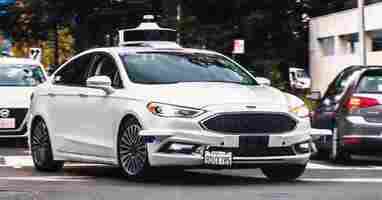The auto sector thinks Tesla’s full of shit with its ‘full self-driving’
Just this weekend, respected New York Times journalist Farhad Manjoo wrote an article about traveling in a Cadillac Escalade embedded with Super Cruise driver-assist technology.

It erroneously stated that by deploying the technology, a driver could “ [their] toes and put [their] hands in the air like [they] just don’t care. “
As well as being cringe-inducing, the article is littered with phrases and descriptions of Manjoo’s behavior while driving that show a fundamental lack of understanding of the abilities of driver-assist technology and what it requires of the driver.
A new name for the Self-Driving Coalition for Safer Streets
And it comes in the week that the Self-Driving Coalition for Safer Streets rebranded itself as the Autonomous Vehicle Industry Association (AVIA). The AVIA represents a unique cross-section of the world’s most innovative technology, automotive, trucking, delivery, and rideshare companies. Its members include Argo AI, Aurora, Cruise, Embark, Ford, Kodiak, Lyft, Motional, Navya, Nuro, TuSimple, Uber, Volvo Cars, Waymo, and Zoox — Tesla is notably absent.


According to the AVIA, the new name aligns with the members’ commitment to precision and consistency in how the industry, policymakers, journalists, and the public talk about autonomous driving technology.
The association recently called on all stakeholders to clearly distinguish between AVs and driver-assist to boost consumer trust and understanding.
I’ve written a whole article that deep dives into the technical differences, but the AVIA provide a nice recap:
And just a reminder, Super Cruise and Tesla’s Full Self-Driving beta are driver-assist programs, NOT examples of vehicle automation software. And if drivers use them with a false sense of security, the results could be devastating.
Ariel Wolf, the general counsel for the AVIA, points out that if a consumer gets in a vehicle with driver-assist features but is under the false impression that the car is “self-driving” or will “drive itself,” that can lead to misuse of the technology.
We’ve seen plenty of examples of that with people driving in the back , making porn movies , and sleeping in their Teslas.
Wolf asserts that this also hurts the advancement and reputation of vehicle automation technology. Especially if journalists mislead consumers to believe that incidences of driver-assist misuse involve a car that was “self-driving.”
If we go back to Manjoo’s article, the author refers to driving assistance as “self-driving systems,” noting that some require the person in the driver’s seat to hold the wheel while Super Cruise dispenses with the wheel touching.
This is misleading, as it suggests the car is driving by itself and is in control. Both Tesla’s FSD and Super Cruise require the driver to be fully aware and responsible for controlling the car, whether their hands are on the wheel or not. They need to fully pay attention and be able to take over the car in a split second without warning. This would not be needed if a car was actually driving itself.
The AVIA is not the only industry insider cleaning up its language
Early last year, ride-hailing company Waymo announced they would no longer reference “self-driving” when referring to their technology. Instead, they use the term fully autonomous driving technology.
The company explained that “some automakers use the term ‘self-driving’ inaccurately, giving consumers and the general public a false impression of the capabilities of driver-assist (not fully autonomous) technology.”
Ok, they haven’t explicitly mentioned Tesla , but I think we can all take an accurate guess who they are talking about.
They stress that this is more than just a branding or linguistic exercise in that a false impression of advanced driver assistance could lead someone to unknowingly take risks (like taking their hands off the steering wheel), jeopardizing not only their own safety but the safety of people around them.
The public perception of vehicle functionality and safety matters. As technology advances, it is vital that the auto industry unites around the terminology it uses.
It’s a crucial driver of its work with lawmakers, regulators, and the public to realize the safety, and societal benefits of autonomous vehicles.
Swapfiets disrupts bike hiring and asserts their green cred
One of the last decade’s real advantages has been the introduction of new business models in micromobility. An example is Swapfiets , which is the world’s first “bicycle as a service” company.

We were, therefore, thrilled to have their CEO, Marc de Vries, take the stage at the TNW 2021 conference and tell us more about how the company is disrupting bike sustainability
Founded in 2014 in the Netherlands, the scale-up has over 260,000 members in the Netherlands, Germany, Belgium, Denmark, France, Italy, Austria, Spain, and the UK.
The concept of Swapfiets is quite simple: For a monthly subscription fee, Swapfiets members receive a fully functional bicycle or e-mobility solution for their own use. If needed, a repair service is available within 48 hours to repair or directly swap the two-wheeler at no additional cost.
The challenges of micromobility during COVID-19
Three students founded the company in 2014. Marc de Vries joined as CEO in January — yes, right in the middle of a pandemic when everyone was working from home. His earliest challenge was getting to know the company and getting a grip on the company’s culture. He noted:
Then, there’s the pressure of coming on board, with an organization growing as its owners matured. As he explained:
Further, the company is not immune to the difficulties of the semiconductor chip shortage . Chips are embedded into both the batteries and the bikes themselves.
Fortunately, the impact was reduced by a valuable partnership. They collaborated to order chips in bulk with suppliers Bosch and Shimano.
Sustainability-first and a move towards a circular economy
Swapfiets is a company that is leading the sector by greening their workflow. Take bike tires. Tires are usually tough to recycle. Earlier this year, the company partnered with Italian tire company Vittoria to improve performance and extend the lifespan of their electric bikes .


Swapfiets has subscribed to the Vittoria2GOservice — renting tires instead of buying them — in a key step towards achieving their goal of creating 100% circular bikes.
In the ”pay for use” business model, the manufacturer handles the value of a product throughout its lifecycle. The model provides an incentive to design products that are optimized for durability, ease of maintenance, and repair.
De Vries notes that the company is in a prime position to rethink the production supply chain. He remarked
that traditionally, most companies gave little thought to what happened to bikes when they were no longer in use. This has shifted to a trend to design bikes to last, creating perpetual bike models of repairing and reusing parts.
The company is aiming to produce a completely circular bike in the next three years.
Introducing Swapfiets’ The Power 1
The company launched its latest bike, The Power 1 in September. It’s named for its single-speed set-up, which means no gears, making it easy to use and maintain.
A Shimano E5000 e-bike system runs The Power 1, offering three levels of electrical assistance up to a top speed of 25kmph. When fully charged, the battery provides a maximum range of up to 80km — perfect for a full day of work and play in the city.
Given how sleek this bike looks, we can’t wait for the fully circular one
Should bike helmets be compulsory?
I came across PedalMe cargo bike company last year, and was impressed. It provides a last-mile cargo and passenger ebike service. All of its riders are employed full-time, with pre-scheduled shifts and hourly pay (instead of the per-delivery income in the gig economy model).

Sounds pretty good, hey? But there’s a quirk — their riders are not allowed to wear bike helmets.


According to the company’s latest newsletter:
They further expanded these ideas on Twitter:
Pedal Me has in-house cycling instructors and a thorough training program. They contend that this and the composition of their bikes means that riders are much less likely to have collisions where helmets will help them.
Instead, they focus on “systematically tackling risk through data collection and data-driven decision making.”
Do they save lives?
Well, it depends on who’s asking and who you ask.
Helmets are made of hard plastic and lined with foam, to state the obvious.
If your head makes contact with a hard object like the ground or a pole, they reduce the force of impact to the skull. However, this is less effective when riding at speed.
Of course, to be effective, a helmet needs to be well fitted. There’s also the problem of counterfeit helmets made in China that come with a local safety sticker but lack the safety benefits.
So the pro-helmet stance holds that they reduce the risk of serious head injury or death.
By comparison, a company like PedalMe subscribes to an idea called Risk Compensation .
This is a school of thought in safety where those wearing protective gear take greater risks and therefore have more collisions. For example, this would posit that those wearing seat belts drive more recklessly than those without.
This approach also looks at the idea of social health. It asks whether the safety aspect of helmets outweighs the health benefits of cycling because helmet laws deter people from taking up cycling.
Where are bike helmets legally required?
Bike helmets are completely mandatory in only a few countries, including Argentina, Finland, Sweden, Namibia, South Africa, Australia, and New Zealand.
And it’s downright confusing in Canada and the US , where laws differ on a local level, according to the state, the city, and the rider’s age.
Last week, Seattle city officials overturned the helmet requirement in response to discriminatory enforcement of the rule against homeless people and people of color. The city of Tacoma had previously repealed the requirement in 2020 due to similar concerns.
The city of Tacoma, Washington, repealed its requirement in 2020, citing similar equity concerns.
What’s it like living somewhere with compulsory helmets?
The idea of not wearing a bicycle helmet seemed really alien to me when I moved to Germany from Australia in 2014.
I find that there are massive differences between Australia and Europe regarding bike safety. When I learned to ride a bike, people told me, “Ride like the car drivers are trying to kill you and stay on the footpath as much as possible.”
The reality is that there is a huge culture of disrespect and antagonism towards cyclists in Australia. We also have poorer quality roads and fewer bike lanes.
There’s little effort to police or prosecute drivers who open their car doors on riders, or drive unsafely around bikes.
And, significantly, unlike places like Berlin and Amsterdam, few drivers are cyclists themselves.
Helmets are a barrier to micromobility success
In 2014 the city of Dallas removed the requirement for people aged 18 and older, as a means of encouraging more bike-sharing. And it worked. C ompulsory helmets make it harder to introduce a cycling culture.
For example, in Australia,
And yes, you needed a helmet. You could buy one cheaply at a nearby 7/11 convenience store for $3.60 ($5 AUD), but these spontaneous rides became difficult when there were no shops nearby.
Incidentally, it’s the same for the current escooters in Australia, but the helmet comes locked to the escooter. A friend told me, “I haven’t got lice yet, fingers crossed!” So maybe, there’s hope yet.
Just for some bang for your buck, I’m going to show you some rather embarrassing and hilarious helmet ads from my childhood:
This one’s got a kinda metaverse meet Second Life vibe:
Apologies for the quality. I suspect the owner ripped them from a VHS cassette….